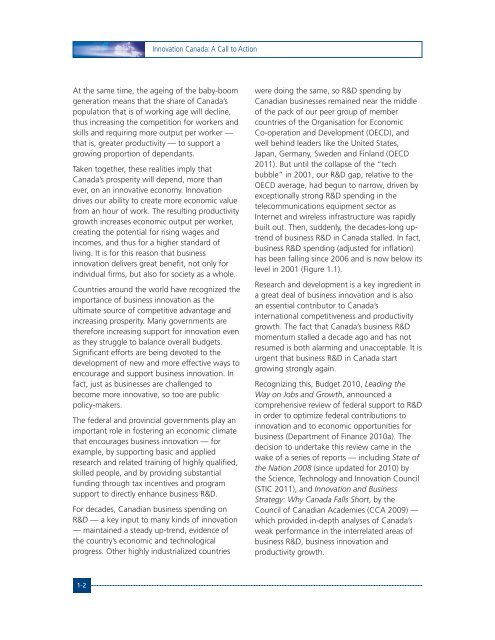Innovation Canada: A Call to Action
Innovation Canada: A Call to Action
Innovation Canada: A Call to Action
Create successful ePaper yourself
Turn your PDF publications into a flip-book with our unique Google optimized e-Paper software.
<strong>Innovation</strong> <strong>Canada</strong>: A <strong>Call</strong> <strong>to</strong> <strong>Action</strong>At the same time, the ageing of the baby-boomgeneration means that the share of <strong>Canada</strong>’spopulation that is of working age will decline,thus increasing the competition for workers andskills and requiring more output per worker —that is, greater productivity — <strong>to</strong> support agrowing proportion of dependants.Taken <strong>to</strong>gether, these realities imply that<strong>Canada</strong>’s prosperity will depend, more thanever, on an innovative economy. <strong>Innovation</strong>drives our ability <strong>to</strong> create more economic valuefrom an hour of work. The resulting productivitygrowth increases economic output per worker,creating the potential for rising wages andincomes, and thus for a higher standard ofliving. It is for this reason that businessinnovation delivers great benefit, not only forindividual firms, but also for society as a whole.Countries around the world have recognized theimportance of business innovation as theultimate source of competitive advantage andincreasing prosperity. Many governments aretherefore increasing support for innovation evenas they struggle <strong>to</strong> balance overall budgets.Significant efforts are being devoted <strong>to</strong> thedevelopment of new and more effective ways <strong>to</strong>encourage and support business innovation. Infact, just as businesses are challenged <strong>to</strong>become more innovative, so <strong>to</strong>o are publicpolicy-makers.The federal and provincial governments play animportant role in fostering an economic climatethat encourages business innovation — forexample, by supporting basic and appliedresearch and related training of highly qualified,skilled people, and by providing substantialfunding through tax incentives and programsupport <strong>to</strong> directly enhance business R&D.For decades, Canadian business spending onR&D — a key input <strong>to</strong> many kinds of innovation— maintained a steady up-trend, evidence ofthe country’s economic and technologicalprogress. Other highly industrialized countrieswere doing the same, so R&D spending byCanadian businesses remained near the middleof the pack of our peer group of membercountries of the Organisation for EconomicCo-operation and Development (OECD), andwell behind leaders like the United States,Japan, Germany, Sweden and Finland (OECD2011). But until the collapse of the “techbubble” in 2001, our R&D gap, relative <strong>to</strong> theOECD average, had begun <strong>to</strong> narrow, driven byexceptionally strong R&D spending in thetelecommunications equipment sec<strong>to</strong>r asInternet and wireless infrastructure was rapidlybuilt out. Then, suddenly, the decades-long uptrendof business R&D in <strong>Canada</strong> stalled. In fact,business R&D spending (adjusted for inflation)has been falling since 2006 and is now below itslevel in 2001 (Figure 1.1).Research and development is a key ingredient ina great deal of business innovation and is alsoan essential contribu<strong>to</strong>r <strong>to</strong> <strong>Canada</strong>’sinternational competitiveness and productivitygrowth. The fact that <strong>Canada</strong>’s business R&Dmomentum stalled a decade ago and has notresumed is both alarming and unacceptable. It isurgent that business R&D in <strong>Canada</strong> startgrowing strongly again.Recognizing this, Budget 2010, Leading theWay on Jobs and Growth, announced acomprehensive review of federal support <strong>to</strong> R&Din order <strong>to</strong> optimize federal contributions <strong>to</strong>innovation and <strong>to</strong> economic opportunities forbusiness (Department of Finance 2010a). Thedecision <strong>to</strong> undertake this review came in thewake of a series of reports — including State ofthe Nation 2008 (since updated for 2010) bythe Science, Technology and <strong>Innovation</strong> Council(STIC 2011), and <strong>Innovation</strong> and BusinessStrategy: Why <strong>Canada</strong> Falls Short, by theCouncil of Canadian Academies (CCA 2009) —which provided in-depth analyses of <strong>Canada</strong>’sweak performance in the interrelated areas ofbusiness R&D, business innovation andproductivity growth.1-2
















